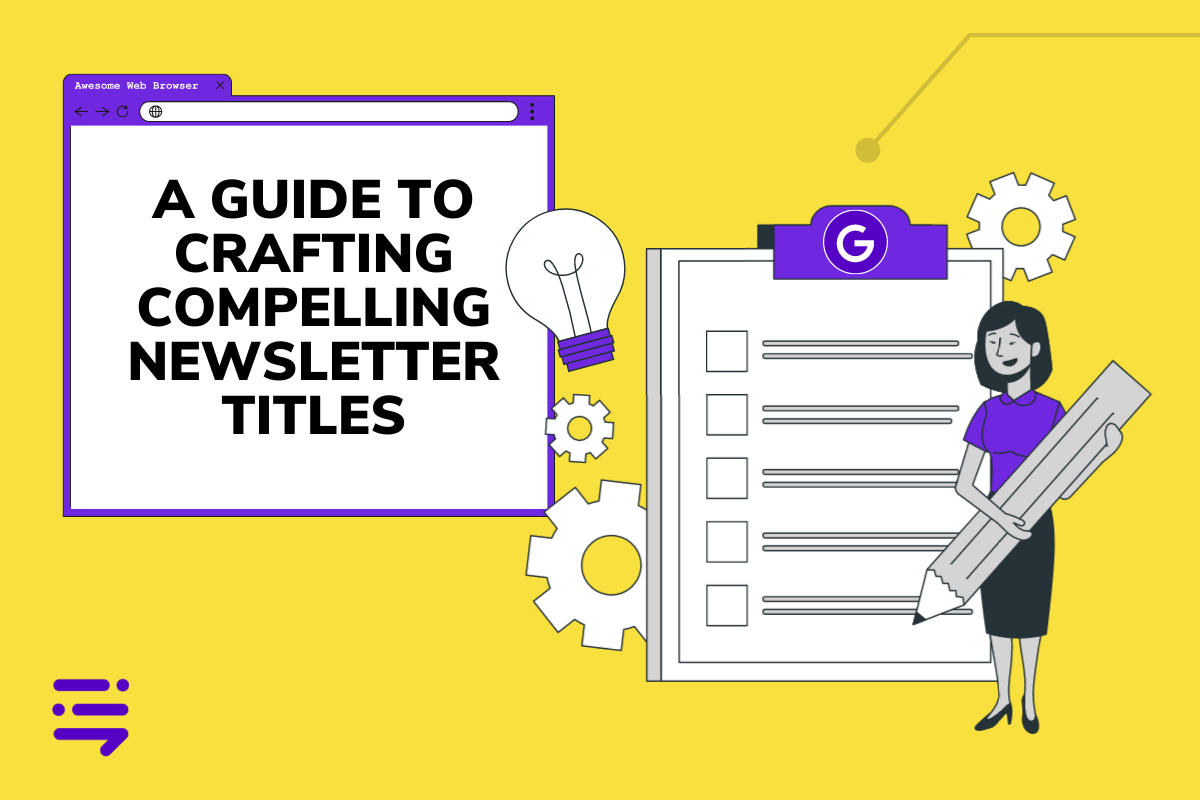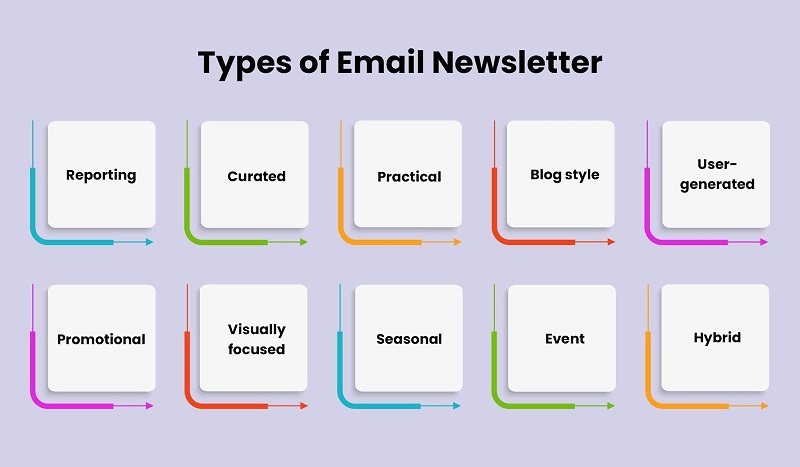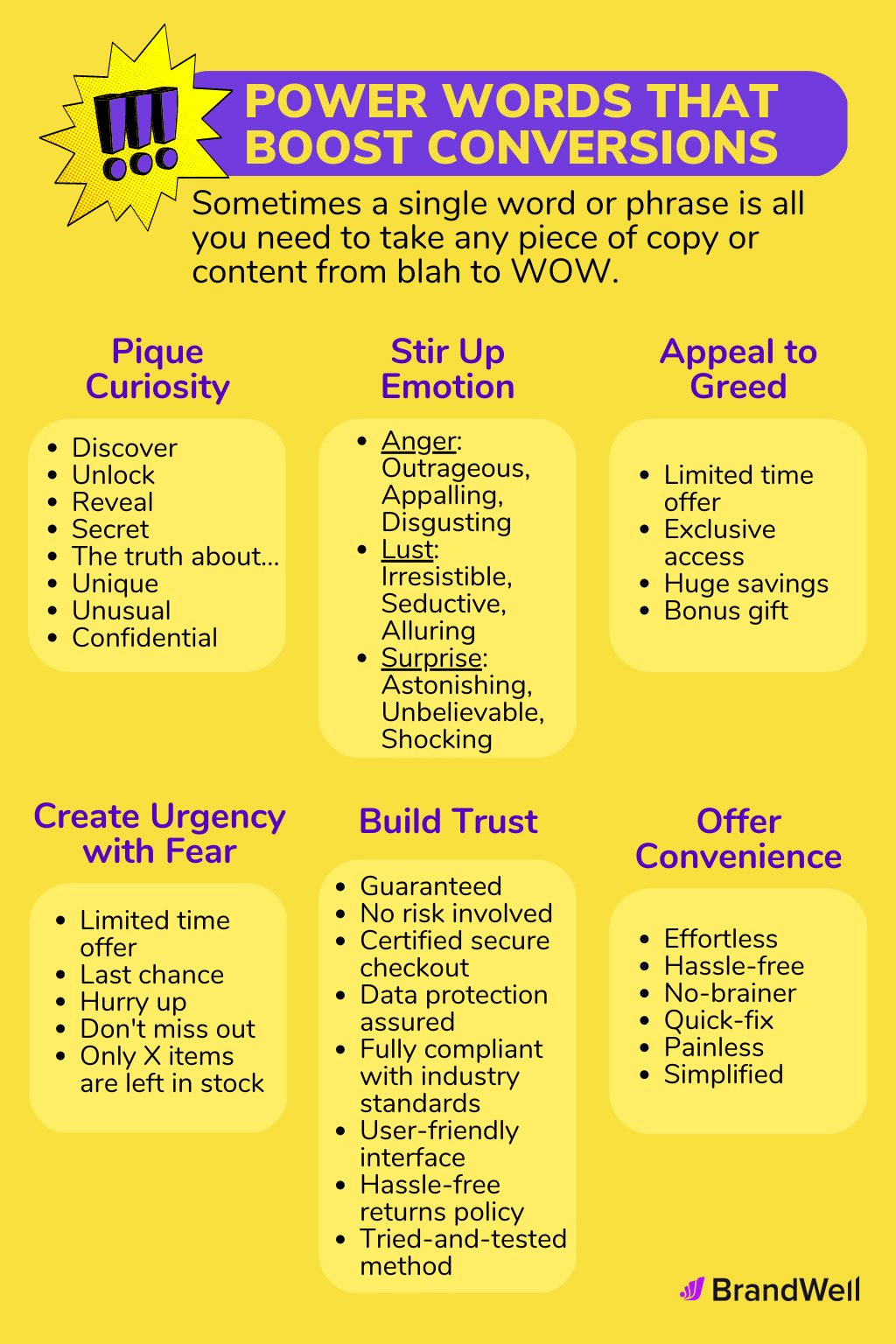Discover top guides, trends, tips and expertise from AIO Writers
Your Guide to Crafting Catchy Newsletter Headlines
Julia McCoy
Monday, 24th Jul 2023
The success of your email marketing strategy lies in your ability to build and nurture a list of engaged subscribers.
One of the ways to do this? Send them interesting newsletters weekly or monthly — depending on your industry.
According to 31% of B2B marketers, newsletters are the most effective way to nurture leads.
Almost 50% of consumers say they would like to receive promotional newsletters from their favorite brands.
As seasoned marketers, we understand the importance of email newsletters in engaging with our audiences and driving conversions. However, creating compelling newsletter titles can be challenging, especially when you have to compete for attention in crowded inboxes.
In this detailed guide to newsletter titles, we’ll explore how to craft irresistible newsletter headlines that grab your subscribers’ attention, keep them hooked from start to finish, and nudge them to take action at the end.
Let’s dive in!
Table Of Contents:
- What Are Newsletters?
- What Are the Benefits of Sending Newsletters?
- Monthly Newsletter Ideas
- Why a Newsletter Title is Important
- How to Write Great Newsletter Headlines
- Different Types of Newsletters for Your Business
- Conclusion
What Are Newsletters?
Newsletters offer a great way to stay connected with customers and build brand loyalty. They are an effective tool for providing valuable information, such as new product launches, upcoming events, or industry news that may be relevant to your audience.
Plus, newsletters can help you increase website traffic by including links back to specific pages on your blog or website.
Since emails are sent directly into the inboxes of subscribers who have already expressed interest in your product, they provide a more targeted approach than other forms of marketing communication like social media posts or banner ads which reach broader audiences.
By consistently delivering valuable information through email newsletters that subscribers anticipate receiving regularly, brands can foster trust with their audiences and establish themselves as authorities within certain industries. Wider audiences that come across these newsletters via referrals also get the chance to know your brand.
What Are the Benefits of Sending Newsletters?
Sending newsletters can provide a multitude of advantages for businesses and organizations, enabling them to engage with their target audience, foster relationships, and accomplish their marketing and communication objectives.
Here are some of the key benefits of sending newsletters:
1. Increased Traffic
When you send out newsletters, it increases the chances of your website being seen by more people. This is because when someone subscribes to your newsletter, they will be sent a link back to your blog or website with every issue.
Furthermore, if the content in the newsletter is engaging and informative enough for readers to share it on their social media accounts, this can result in even more traffic coming to your website from those referrals.
2. Improved SEO Rankings
Sending out newsletters also helps improve SEO rankings for websites that are linked within them as well as providing an additional platform for getting quality links back to a site.
Additionally, having fresh content regularly published through newsletters can help boost overall organic visibility since Google loves fresh content and rewards sites accordingly.
3. Higher Conversion Rates
Regularly sending out newsletters can lead to increased conversion rates due to better engagement levels with customers who already subscribe or follow you online. It can also help attract new leads who may not have known you before but were interested enough in what they saw on social media.



Unlayer breaks down the different types of email newsletters
Monthly Newsletter Ideas
Apart from the usual company updates and seasonal promos, there are unique topics that can spark your readers’ interest. Here are a few ideas for your next newsletter issue.
How-To Guides
Everyone loves a good how-to guide. Fortunately, they are easy to write and can be tailored to any aspect of your business.
For instance, if you’re selling clothes, create a guide on how customers can accessorize your products.
If you run a tour guide service, offer a step-by-step guide on finding unknown gems in certain locations – complete with visuals that link back to your Instagram or YouTube channels.
Top 10 Lists
Quick and easy to scan, top 10 lists are surefire ways of keeping subscribers engaged. The list format ensures readers don’t have clunky walls of text and will keep them scrolling until the end for the number one spot.
You could write about topics like “the top 10 most popular products from our store” or “top 10 things to look forward to this year from our industry” – just two examples out of many possible ideas.
User-Generated Content
Interaction is paramount when attempting to get users to come back for more content. User-generated content can be a powerful way of demonstrating that a brand is genuine and demonstrates concern toward its customers.
Invite followers/subscribers to share their experience with your product and ask them what could be improved upon. Run polls so they can express their views. Showcase customer reviews and testimonials.
All these tactics help foster engagement while also improving SEO rankings.
Why a Newsletter Title is Important
A newsletter title is an important part of any email marketing strategy. It’s the first thing readers will see and can be a deciding factor in whether they read through or not. A creative, eye-catching title can help draw attention to your message and increase engagement with your content.
Crafting creative titles can help you further differentiate yourself from competitors, so let’s explore how to make your newsletters really shine.
Here’s your guide to newsletter headlines that stand out and snag your reader’s attention.
How to Write Great Newsletter Headlines
Creating an eye-catching newsletter title is a great way to draw attention and encourage readership. An effective newsletter title should be creative, interesting, and relevant to the rest of the content.
1. Brainstorm Ideas
Start by thinking about what you want to communicate in the newsletter. Is there a key theme or message? Use this as inspiration for creating a catchy headline that reflects the overall tone of the piece.
Brainstorm ideas for titles that will grab readers’ attention. Think about words or phrases related to your topic that could be used as part of the title or even as its own phrase.
2. Use Action Words
Try to use action words such as “Discover”, “Unlock”, or “Explore” which suggest movement and excitement – these will make your headlines more interesting and engaging.
Additionally, consider adding words like “Secrets” or “Insider Tips” which suggest exclusive information not available elsewhere – another powerful way to entice potential subscribers.


3. Keep Titles Brief
Your headline should be short enough so it doesn’t get cut off when shared on social media platforms but long enough so you don’t sacrifice any important details about what’s inside the issue.
Your newsletter titles should be concise yet descriptive – ideally no longer than five words long – so that readers can quickly understand what your content is about. Avoid using overly complicated language or jargon as this may confuse people instead of enticing them to read on.
Maintaining brevity in the headline will avoid information overload.
4. Add Numbers and Symbols
Adding numbers (e.g., “10 Ways To…”) or symbols (e.g.,”@”) can add an extra layer of interest while helping break up longer headlines to make them easier on the eyes.
5. Make it Memorable
A great newsletter title should be memorable enough for people to recall after they’ve read it. Consider using puns, alliteration, wordplay, rhymes, or idioms if appropriate for your audience and subject matter to make your title stand out.
6. Don’t Forget About Aesthetics
The size of the font should be substantial but not so large as to overpower other elements on the page. Consider how color might affect readability – bright colors tend to work best since they attract attention quickly whereas muted tones may blend into background noise.
Always keep your audience in mind when crafting titles. This will help ensure that you create headlines that appeal directly to their interests while also staying true to your brand messaging.
By following these tips, you can make sure that your titles stand out and draw in more subscribers.
Running out of ideas for your newsletter headlines? BrandWell‘s AIMEE chatbot can generate catchy titles for you in an instant! Here’s an example of 10 headlines it wrote for a new dog food brand:


Different Types of Newsletters for Your Business
Newsletters can be a valuable tool for businesses to engage with their audience, build relationships, and promote their products or services. There are various types of newsletters, depending on your goals and target audience.
Here are some common types of newsletters for your business:
Informative Newsletters
These are newsletters that contain the latest company or product news and let customers know about upcoming events, product or service launches, or general news in the industry. This type of newsletter is useful for keeping customers informed on what’s happening with your business and any changes you may be making. It also gives them an idea of what to expect from your brand in the future.
For example, if you have a new product launch coming up soon, this would be a great opportunity to include information about it in an informative newsletter.
Here’s an example of a product announcement email from Casper:



Helpful Newsletters
Helpful newsletters answer customer questions, give insight into products and services, and offer assistance in navigating your website.
These types of newsletters provide helpful tips and advice that helps customers get more out of their experience with your brand.
Examples might include video tutorials on how to use your new product feature, such as the one below from Design Files.



Promotional Newsletters
Promotional newsletters contain such things as limited-time offers, coupons, discounts, and other financial opportunities. These types of emails are great for getting people excited about sales events or special deals.
Promotional emails should always be clear and concise so readers understand exactly what’s being offered without having to sift through too much text before finding the details they need.
Here’s Virgin Airlines announcing an 8-hour sale:



Event Newsletters
If your company hosts many events such as charity drives, product launches, trade shows, or seminars, then event newsletters will help keep everyone informed. They allow readers to stay updated before and after an event, which makes them feel like part of something bigger.
Recaps after each event also provide insights into how successful it was, plus some fun photos from attendees.
Here’s an example of an event newsletter from market research firm Mintel:



Business Newsletters
This type of newsletter focuses on sharing updates and news about the company. It may include information about new team members, achievements, events, or milestones.
In the example below, CharityWater.org shares how their non-profit organization grew from a simple idea among friends into what it is today.



Interactive Newsletters
An interactive newsletter goes beyond traditional static content to encourage engagement and participation from the audience. These interactive elements can enhance the user experience and make the newsletter more memorable.
Interactive content may include quizzes, surveys, polls, interactive infographics, videos, gamification, user-generated content, interactive maps, and clickable CTA buttons.
Here’s an example from Lyft:



Seasonal/Holiday Newsletters
These newsletters are centered around specific holidays or seasons and may offer holiday-themed promotions, gift guides, or content relevant to the occasion.
Here’s how Nordstrom greeted its customers in a Thanksgiving email:



Conclusion
Newsletters continue to be a staple in any content marketing strategy because they allow brands to connect and engage with customers without sounding overly sales-y. But for newsletters to be successful, your content has to be fresh, original, and value-oriented. This keeps readers from hitting that dreaded “Unsubscribe” button.
Creating a great newsletter title can be the difference between readers opening your email or deleting it.
Be sure to craft titles that are eye-catching, creative, and punchy so they stand out in inboxes.
Have you been staring for hours at a blank screen with no ideas flowing? Launch AIMEE from your browser to get headline suggestions in an instant! Just enter your topic, purpose, and target audience and you’ll get catchy title ideas within minutes.

UNLOCK YOUR POTENTIAL
Long Headline that highlights Value Proposition of Lead Magnet
Grab a front row seat to our video masterclasses, interviews, case studies, tutorials, and guides.



